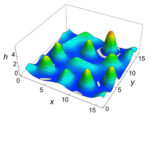Bare quantum dots boost UV photoluminescence

Nitride-based devices are common in common electronic or opto-electronic devices (white LED, blue laser diodes…). The developpement of new materials based on Alx Ga1-xN allow, by varying x, to span a large ultra-violet spectrum that is interesting e.g. for water purification or sanitization. Their epitaxial growth is often characterized by a large density of defects, but the growth of GaN on Alx Ga1-xN leads to quantum dots that lessen their impact and enhence UV emission. More surprisingly, researchers in CRHEA showed that after an annealing with evaporation, the wetting layer that spreads in between dots and is traditional in the Stransky-Krastanov mode, disappears and leads to nanostructures with an amplified UV emission. The understanding and control of this evolution requires the description of the out-of-equilibrium dynamics, that has been done in collaboration INSP/InPHY, revealing a new epitaxial growth mode.
Caption: Modeling the growth of quantum dots without a wetting layer.
Reference
“Wetting-Layer-Free AlGaN Quantum Dots for Ultraviolet Emitters”
G. Schifani, T. Frisch, J. Brault, P. Ennéguès, S. Matta, M. Korytov, B. Damilano, J. Massies, J.-N. Aqua
ACS Appl. Nano Mater. 3, 4054 (2020)

